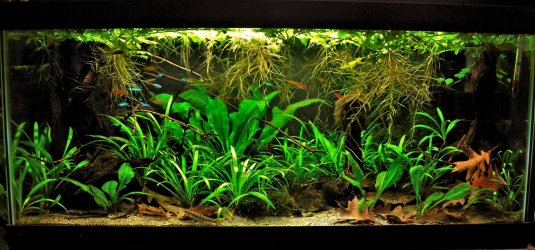Andrew waterson
New Member
- Joined
- Aug 15, 2018
- Messages
- 43
- Reaction score
- 4
Hi All,
My tanks been up and running for a few months now, but I've started to develop BBA
Its still in small patches at the edge of leaves and lava rock and a few clumps on gravel, but I'm aware this can become a bit of a nightmare to deal with if left unchecked
Tank info
-160L community tank with dwarf rainbows, bronze cory's, gupies and a pearl gourami (+ a few unintended zebra danios!)
-25 degrees with 0 ammonia and nitrite, nitrate is approx 20-30ppm (in tap water)
-PH is steady at 8.2
-Lights are 2 30w T8's (K is unknown as I can't find the info, they are intepet T8 Community Daylight For Tropical & Coldwater - 30W 36''/91cm)
-Planted with Amazon swords, java ferms, valliseria (std one from LFS) and edolea (guessing at densa)
-Lights are on for approx off for 12hrs a day and its not in direct sunlight
-I use root tabs and just started with prime flourish comprehensive
-Filter and flow should be ok as i have 2 filters (1 hob 1 power head) with way over 10x an hr. I have the power head outlet pointed up to lessen the strengthen of the flow as the fish as all under 7cm so its a bit too strong! Also have an air pump with 2 lines with airstones
-I don't use C02
I was going to start using prime excel as it suggested it good at getting rid of BBA, but I've seen very mixed opinions and it sounds like damages primitive plants (which i think all of mine are but the swords!)
What's the expert opinion on Excel and these type of plants?
I was also considering if the is there a good snail option for BBA and my water parameters
I know the cause of BBA will be an imbalance of some kind, but I very much doubt my ability to find it!
Heavy duty stripping down\bleaching is out (other than in desperation) as the fish all seem happy and settled and the plants are doing well (just planted baby ferns that grew on the ends of leaves and baby swords on the flower stalks are almost big enough to separate), again I doubt my ability to do it without harming them!
Any help greatly welcomed
My tanks been up and running for a few months now, but I've started to develop BBA
Its still in small patches at the edge of leaves and lava rock and a few clumps on gravel, but I'm aware this can become a bit of a nightmare to deal with if left unchecked
Tank info
-160L community tank with dwarf rainbows, bronze cory's, gupies and a pearl gourami (+ a few unintended zebra danios!)
-25 degrees with 0 ammonia and nitrite, nitrate is approx 20-30ppm (in tap water)
-PH is steady at 8.2
-Lights are 2 30w T8's (K is unknown as I can't find the info, they are intepet T8 Community Daylight For Tropical & Coldwater - 30W 36''/91cm)
-Planted with Amazon swords, java ferms, valliseria (std one from LFS) and edolea (guessing at densa)
-Lights are on for approx off for 12hrs a day and its not in direct sunlight
-I use root tabs and just started with prime flourish comprehensive
-Filter and flow should be ok as i have 2 filters (1 hob 1 power head) with way over 10x an hr. I have the power head outlet pointed up to lessen the strengthen of the flow as the fish as all under 7cm so its a bit too strong! Also have an air pump with 2 lines with airstones
-I don't use C02
I was going to start using prime excel as it suggested it good at getting rid of BBA, but I've seen very mixed opinions and it sounds like damages primitive plants (which i think all of mine are but the swords!)
What's the expert opinion on Excel and these type of plants?
I was also considering if the is there a good snail option for BBA and my water parameters
I know the cause of BBA will be an imbalance of some kind, but I very much doubt my ability to find it!
Heavy duty stripping down\bleaching is out (other than in desperation) as the fish all seem happy and settled and the plants are doing well (just planted baby ferns that grew on the ends of leaves and baby swords on the flower stalks are almost big enough to separate), again I doubt my ability to do it without harming them!
Any help greatly welcomed





